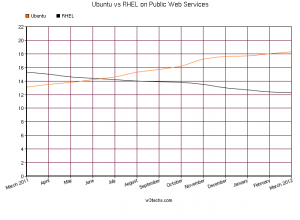Is Ubuntu becoming a big name in enterprise Linux servers?

When you think of Ubuntu Linux, what do you think of? I would guess you think about the Linux desktop. While Ubuntu is certainly a big player—maybe the biggest—when it comes to the Linux desktop, Mark Shuttleworth, founder of Canonical, the company behind Ubuntu wants you to know that “A remarkable thing happened this year: companies started adopting Ubuntu over RHEL for large-scale enterprise workloads, in droves.”
Shuttleworth makes this claim because, according to W3Tech, which surveys technologies used on the Web, shows that since July 2011 Ubuntu has overtaken Red Hat Enterprise Linux (RHEL) for Web servers. According to W3Techs, as of February, “Ubuntu s now used on 6% of all Web servers, up from 4% one year ago.”
Shuttleworth choose Web servers for his benchmark because “Web services are a public affair.” Nevertheless, Shuttleworth claims that “the trend is even starker if you look at what we know of new-style services, like clouds and big data.”
He may be on to something. In my own research, I found that Cloud Market, a group that scans the Amazon EC2 cloud use shows Ubuntu is the top operating system with almost 12-thousand instances. Generic Linux comes in second trailing by thousands, and Windows is far behind in third with 3,58-thousand instances. Combining RHEL with its clone CentOS, the Red Hat family came in with about 2.3-thousand.
Now Cloud Market is measuring Amazon Machine Image (AMI), a pre-configured operating system and virtual application software which is used to create a virtual machine, not the number of running systems. As Shuttleworth told me during our e-mail discussion of Cloud Market's data “I would characterize it as an easily gamed measure of innovation (i.e. a measure that will become less useful if lots of people start talking about it :-) rather than a measure of adoption. It's a measure of how many people have taken the OS and done their own snapshot with their own customizations, not a measure of how many of each of those images is running.” Since, however, no one to my knowledge has been looking at Cloud Market's data in this way it strikes me as still showing serious business server interest in Ubuntu.
So why are people looking at Ubuntu for servers? In his blog posting Shuttleworth wrote, “The key driver of this has been that we added quality as a top-level goal across the teams that build Ubuntu – both Canonical’s and the community’s. We also have retained the focus on keeping the up-to-date tools available on Ubuntu for developers, and on delivering a great experience in the cloud, where computing is headed.”
Sure, “The headlines for Ubuntu have all been about the desktop and consumer-focused design efforts, with the introduction of Unity and the expansion of our goals to span the phone, the tablet, the TV as well as the PC. But underpinning those goals has been a raising of the quality game.”
Looking ahead, Shuttleworth wrote, “12.04 LTS [Long Term Support] is a coming of age release for Ubuntu in the data centre as much as its the first LTS to sport the interface which was designed to span the full range of personal computing needs. At the same time he notes that “OpenStack’s [the popular open-source cloud platform) Essex release is lined up to be a perfect fit for 12.04 LTS. That is not a coincidence, it’s a value to which both projects are committed. Upstream projects that care about their user’s and care about being adopted quickly, want an effective conduit of their goodness straight to users. By adopting the 6-month / 2-year cadence of step and LTS releases, and aligning those with Ubuntu’s release cycle, OpenStack ensures that a very large audience of system administrators, developers and enterprise decision makers can plan for their OpenStack deployment, and know they will have a robust and very widely deployed LTS platform together with a very widely supported release of OpenStack.”
Shuttleworth concluded, “Every dependency that Essex needs is exactly provided in 12.04 LTS, the way that all of the major public clouds based on OpenStack are using it. By adopting a common message on releases, we make both OpenStack and Ubuntu stronger, and do so in a way which is entirely transparent and accessible to other distributions.”
So is Ubuntu ready to take on RHEL? I think Ubuntu's getting to be a significant server player, but it's not at Red Hat's level yet. Red Hat is closing in on being the first pure-play Linux and open-source company with a billion in annual revenue. Canonical, while privately held, isn't in that ballpark yet. In addition, Web servers, which Shuttleworth uses as the foundation for his claim, are edge servers and not really enterprise servers as such.
Still, Canonical's flagship Linux is clearly adopted by more and more businesses. I can well believe that the race for being the number one Linux server in the 2010s might have Canonical and Ubuntu nipping at Red Hat's heels rather than SUSE or Oracle.
Related Stories:
Shuttleworth on the Ubuntu Linux 12.04 beta
What does Ubuntu want to be when it grows up?
Linux users cautiously optimistic about Ubuntu's Head-Up Display desktop
Oracle's Unbreakable Enterprise Kernel 2 arrives with Linux 3.0 kernel, btrfs SUSE ships Enterprise Linux SP2, the first under new management
